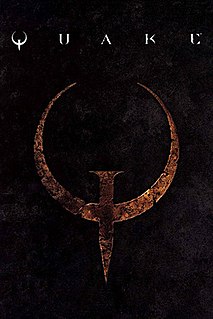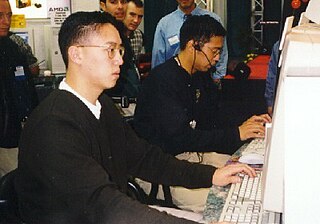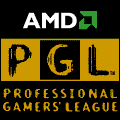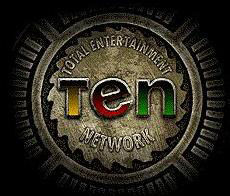
Machinima, originally machinema is the use of real-time computer graphics engines to create a cinematic production. Most often, video games are used to generate the computer animation. The word "machinima" is a portmanteau of the words machine and cinema.

Quake III Arena is a 1999 multiplayer-focused first-person shooter developed by id Software. The third installment of the Quake series, Arena differs from previous games by excluding a story-based single-player mode and focusing primarily on multiplayer gameplay. The single-player mode is played against computer-controlled bots. It features music composed by Sonic Mayhem and Front Line Assembly founder Bill Leeb.

Quake is a first-person shooter game developed by id Software and published by GT Interactive. The first game in the Quake series, it was originally released for MS-DOS, Microsoft Windows and Linux in 1996, followed by Mac OS and Sega Saturn in 1997 and Nintendo 64 in 1998. In the game, players must find their way through various maze-like, medieval environments while battling monsters using an array of weaponry. The overall atmosphere is dark and gritty, with many stone textures and a rusty, capitalized font. Quake takes heavy inspiration from gothic fiction and the works of H. P. Lovecraft.

Stevana "Stevie" Case is an American businesswoman. She is known for competing in the first-person shooter game Quake in the late 1990s, as well as contributing professionally to the video game industry.

John D. Carmack II is an American computer programmer and video game developer. He co-founded the video game company id Software and was the lead programmer of its 1990s games Commander Keen, Wolfenstein 3D, Doom, Quake, and their sequels. Carmack made innovations in 3D computer graphics, such as his Carmack's Reverse algorithm for shadow volumes. In 2013, he resigned from id to work full-time at Oculus VR, where he served as CTO and later Consulting CTO in 2019.
A LAN party is a gathering of people with computers or compatible game consoles, where a local area network (LAN) connection is established between the devices using a router or switch, primarily for the purpose of playing multiplayer video games together. The size of these networks may vary from as few as two people to very large gatherings of a hundred or more. Small parties can form spontaneously and take advantage of common household networking equipment, but larger ones typically require more planning, equipment, and preparation.
Game programming, a subset of game development, is the software development of video games. Game programming requires substantial skill in software engineering and computer programming in a given language, as well as specialization in one or more of the following areas: simulation, computer graphics, artificial intelligence, physics, audio programming, and input. For multiplayer games, knowledge of network programming is required. In some genres, e.g. fighting games, advanced network programming is often demanded, as the netcode and its properties are considered by players and critics to be some of the most important metrics of the game's quality. For massively multiplayer online games (MMOGs), even further knowledge of database programming and advanced networking programming are required. Though often engaged in by professional game programmers, some may program games as a hobby, spawning a thriving scene of so-called indie game developers.
Direct3D and OpenGL are competing application programming interfaces (APIs) which can be used in applications to render 2D and 3D computer graphics. As of 2005, graphics processing units (GPUs) almost always implement one version of both of these APIs. Examples include: DirectX 9 and OpenGL 2 circa 2004; DirectX 10 and OpenGL 3 circa 2008; and most recently, DirectX 11 and OpenGL 4 circa 2011. GPUs that support more recent versions of the standards are backwards compatible with applications that use the older standards; for example, one can run older DirectX 9 games on a more recent DirectX 11-certified GPU.
A personal computer game, also known as a PC game or computer game, is a type of video game played on a personal computer (PC) rather than a video game console or arcade machine. Its defining characteristics include: more diverse and user-determined gaming hardware and software; and generally greater capacity in input, processing, video and audio output. The uncoordinated nature of the PC game market, and now its lack of physical media, make precisely assessing its size difficult. In 2018, the global PC games market was valued at about $27.7 billion.

Dennis Fong, better known by his online alias Thresh, is an American businessman and retired professional player of the first-person shooter video games Quake and Doom. He is a co-founder of Xfire, an instant messenger and social networking site for gamers, which was acquired by Viacom for US$102 million in April 2006. He also co-founded Lithium Technologies, a social customer relationship management (CRM) company. In his playing career his highest profile victory came in 1997 at the Red Annihilation Quake tournament, where he placed first and won id Software CEO John D. Carmack's Ferrari 328. Fong is recognized by the Guinness World Records as the first professional gamer.
Rendition was a maker of 3D computer graphics chipsets in the mid to late 1990s. They were known for products such as the Vérité 1000 and Vérité 2x00 and for being one of the first 3D chipset makers to directly work with Quake developer John Carmack to make a hardware-accelerated version of the game (vQuake). Rendition's major competitor at the time was 3Dfx. Their proprietary rendering APIs were Speedy3D and RRedline.

Ed Fries ( "freeze") is an American video game programmer and entrepreneur who was the vice president of game publishing at Microsoft during much of the Xbox's life-cycle.

Mplayer, referred to as Mplayer.com by 1998, was a free online PC gaming service and community that operated from late 1996 until early 2001. The service at its peak was host to a community of more than 20 million visitors each month and offered more than 100 games. Some of the more popular titles available were action games like Quake, Command & Conquer, and Rogue Spear, as well as classic card and board for more casual gamers. Servers and matchmaking was provided through a proprietary client. Initially, the service was subscription-based, but by early 1997, they became the first major multiplayer community to offer games to be played online through their network for free. This was done by relying on advertisement-based revenues.

The AMD Professional Gamers League (PGL), founded around 1997, was one of the first professional computer gaming eSports leagues. The PGL was run by Total Entertainment Network and was sponsored by AMD. The first professional tournament they held was for StarCraft in September 1997. The league was official unveiled at a press conference at Candlestick Park in San Francisco on November 3, 1997. It was sponsored by Microsoft, Nvidia, and Levi Strauss & Co. The organization raised over $1.2mil USD in sponsorship money.

Sujoy Roy is a former professional online gamer based in the United Kingdom. He lives in Camden, Central London.

Total Entertainment Network (TEN) was an online gaming service that existed from September 1996 until October 1999. T E Network, Inc., which created and operated the TEN service, was formed from the merger of Optigon Interactive and Outland in June 1995 when they received their first round of venture capital funding from Vinod Khosla, a general partner at Kleiner Perkins Caufield & Byers.

The Dial-up Wide-Area Network Game Operation, better known by the acronym DWANGO, was an early online gaming service based in the United States. Launched in 1994, it was originally known for its compatibility with Doom, for which it functioned as a matchmaking service for online multiplayer. The service also supported various other titles, including other id Software games such as Doom II and Heretic as well as titles from other companies like Duke Nukem 3D, Blood, and Shadow Warrior from 3D Realms.

AssaultCube, formerly ActionCube, is an open source first-person shooter video game, based on Cube and use the same engine, the Cube Engine. Although the main focus of AssaultCube is multiplayer online gaming, a single-player mode consists of computer-controlled bots.
Fragapalooza is an annual video game festival/LAN party that takes place in Leduc, Alberta, Canada. The Name Fragapalooza was derived from the Military Slang "Frag" and "palooza" which is the suffix for any type of named festival or gathering like lollapalooza. Traditionally held in the summer, it runs over a period of four days, approximately 72 hours of non-stop gaming. It was considered Canada's largest LAN party event having reached approximately 900 attendees at its peak in 2008 and is still considered one of the largest events in the country and the largest in Western Canada.












